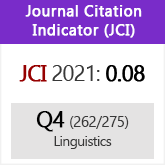Metrically conditioned pitch and layered feet in Chugach Alutiiq
DOI:
https://doi.org/10.3989/loquens.2016.030Keywords:
metrical phonology, phonological representations, ternary stress, metrically conditioned pitchAbstract
This article presents a reanalysis of the foot-based phonology of Chugach Alutiiq (henceforth CA), a language that displays a complex mixed ternary–binary rhythm, as well as metrically conditioned distributions of pitch, fortition and vowel lengthening. Elaborating on earlier analyses of CA that had posited some kind of ternary constituent (Hewitt, 1991, 1992; Leer, 1985a, 1985b, 1985c; Rice, 1992), we propose CA should be analyzed by means of the Internally Layered Ternary (ILT) foot, a minimal recursive foot (Prince, 1980; Selkirk, 1980), which was recently revived in a typological study of binary–ternary stress (Martínez-Paricio & Kager, 2015). It will be argued that ILT feet capture CA’s puzzling dual behavior of unstressed and stressed syllables straightforwardly by referring to the status of syllables as heads or dependents of minimal or non-minimal feet. After showing the value of ILT feet in the analysis of CA rhythmic and segmental patterns, we turn to our analytical focus, the distributions of high and low pitch. This distribution is arguably metrically conditioned, yet an analysis based on stress or standard binary feet cannot capture it, whereas the ILT approach can. To highlight the advantages of our approach, we end by offering brief comparisons with previous analyses of CA.
Downloads
References
Beckman, J. N. (1998). Positional faithfulness (Doctoral dissertation). University of Massachussetts Amherst. Retrieved from http://roa.rutgers.edu/files/234-1297/234-1297-BECKMAN-6-0.PDF
Bennett, R. T. (2012). Foot-conditioned phonotactics and prosodic constituency (Doctoral dissertation). Santa Cruz: University of California.
Bickmore, L. S. (1995). Tone and stress in Lamba. Phonology, 12(3), 307–341. http://oadoi.org/10.1017/S0952675700002542 https://doi.org/10.1017/S0952675700002542
Buckley, E. (2009). Locality in metrical typology. Phonology, 26(3), 389–435. http://oadoi.org/10.1017/S0952675709990224 https://doi.org/10.1017/S0952675709990224
Crowhurst, M. J. (1992). Minimality and foot structure in metrical phonology and prosodic morphology. Bloomington, IL: Indiana University Linguistics Club.
Davis, S., & Cho, M.?H. (2003). The distribution of aspirated stops and /h/ in American English and Korean: An alignment approach with typological implications. Linguistics, 41(4), 607–652. https://doi.org/10.1515/ling.2003.020
De Lacy, P. (2002). The interaction of tone and stress in Optimality Theory. Phonology, 19(1), 1–32. https://doi.org/10.1017/S0952675702004220
De Lacy, P. (2004). Markedness conflation in Optimality Theory. Phonology, 21(2), 145–199. https://doi.org/10.1017/S0952675704000193
De Lacy, P. (2006). Markedness: Reduction and preservation in phonology. Cambridge: Cambridge University Press. https://doi.org/10.1017/CBO9780511486388
Dresher, B. E., & Lahiri, A. (1991). The Germanic foot: Metrical coherence in Old English. Linguistic Inquiry, 22(2), 251–286.
Elenbaas, N., & Kager, R. (1999). Ternary rhythm and the lapse constraint. Phonology, 16(3), 273–329. https://doi.org/10.1017/S0952675799003772
Goldsmith, J. (1976). Autosegmental phonology (Doctoral dissertation). MIT [Published in 1979, New York: Garland].
Goldsmith, J. (1987). Tone and accent, and getting the two together. In J. Aske, N. Beery, L. Michaelis & H. Filip (Eds.), Proceedings of the 13th Annual Meeting of the Berkeley Linguistic Society (pp. 88–104). https://doi.org/10.3765/bls.v13i0.1827
Gordon, M. (2002). A factorial typology of quantity-insensitive stress. Natural Language & Linguistic Theory, 20(3), 491–552. https://doi.org/10.1023/A:1015810531699
Green, T., & Kenstowicz, M. (1996). The lapse constraint. Proceedings of the 6th Annual Meeting of the Formal Linguistics Society of the Midwest (pp. 1–15).
Grijzenhout, J. (1990). Modern Icelandic foot formation. In R. Bok?Bennema & P. Coopmans (Eds.), Linguistics in the Netherlands (pp. 53–62). Dordrecht: Foris.
Gussenhoven, C. (2004). The phonology of tone and intonation. Cambridge: Cambridge University Press. https://doi.org/10.1017/CBO9780511616983
Halle, M. (1990). Respecting metrical structure. Natural Language & Linguistic Theory, 8(2), 149–176. https://doi.org/10.1007/BF00208522
Halle, M., & Vergnaud, J.?R. (1987). An essay on stress. Cambridge, MA: MIT Press.
Hammond, M. (1995). Deriving ternarity. University of Arizona Linguistics Circle. Retrieved from http://hdl.handle.net/10150/311745.
Hayes, B. P. (1980/1985). A metrical theory of stress rules. New York: Garland Press.
Hayes, B. (1995). Metrical stress theory: Principles and case studies. Chicago, IL: Chicago University Press.
Hewitt, M. S. (1991). Binarity and ternarity in Alutiiq. In J. Ann & K. Yoshimura (Eds.), Proceedings of Arizona phonology conference, Vol. 4 (pp. 44–60). Retrieved from http://hdl.handle.net/10150/227270
Hewitt, M. S. (1992). Vertical maximization and metrical theory (Doctoral dissertation). Waltham, MA: Brandeis University.
Houghton, P. (2006). Ternary stress. Amherst: University of Massachusetts. Retrieved from http://roa.rutgers.edu/files/836-0606/836-HOUGHTON-0-0.PDF
Hulst, H. van der (2010). A note on recursion in phonology. In H. v. d. Hulst (Ed.), Recursion and human language. De Gruyter Mouton. https://doi.org/10.1515/9783110219258.299
Hyde, B. (2001). Metrical and prosodic structure in optimality theory (Doctoral dissertation). New Brunswick, NJ: Rutgers University.
Hyde, B. (2002). A restrictive theory of metrical stress. Phonology, 19(3), 313–359. https://doi.org/10.1017/S0952675703004391
Hyde, B. (2015). Overlap, recursion, and ternary constructions. Paper presented at the Workshop on Formal Typologies, Rutgers University.
Hyman, L. M. (1985). A theory of phonological weight. Dordrecht: Foris.
Idsardi, W. J. (1992). The computation of prosody (Doctoral dissertation). Massachusetts Institute of Technology.
Ito, J., & Mester, A. (2007). Prosodic adjunction in Japanese compounds. MIT Working Papers in Linguistics, 55, 97–111.
Ito, J., & Mester, A. (2009). The onset of the prosodic word. In S. Parker (Ed.), Phonological argumentation: Essays on evidence and motivation (pp. 227–260). London: Equinox.
Ito, J., & Mester, A. (2013). Prosodic subcategories in Japanese. Lingua, 124, 20–40. https://doi.org/10.1016/j.lingua.2012.08.016
Jacobson, S. (1985). Siberian Yupik and Central Yupik prosody. In M. Krauss (Ed.), Yupik Eskimo prosodic systems: Descriptive and comparative studies (pp. 25–46). Fairbanks: Alaska Native Language Center, University of Alaska.
Jensen, J. T. (2000). Against ambisyllabicity. Phonology, 17(2), 187–235. https://doi.org/10.1017/S0952675700003912
Kager, R. (1989). A metrical theory of stress and destressing in English and Dutch. Dordrecht: Foris. PMCid:PMC171457
Kager, R. (1993). Alternatives to the iambic-trochaic law. Natural Language & Linguistic Theory, 11(3), 381–432. https://doi.org/10.1007/BF00993165
Kager, R. (1994). Ternary rhythm in alignment theory. Retrieved from http://roa.rutgers.edu/files/35-1094/35-1094-KAGER-0-0.PDF
Kager, R. (2012). Stress in windows: Language typology and factorial typology. Lingua, 122(13), 1454–1493. https://doi.org/10.1016/j.lingua.2012.06.005
Kager, R., & Martínez-Paricio, V. (forthcoming a). The internally layered foot in Dutch.
Kager, R., & Martínez-Paricio, V. (forthcoming b). Mora and syllable accentuation–Typology and representation.
Leer, J. (1985a). Prosody in Alutiiq. In M. Krauss (Ed.), Yupik Eskimo prosodic systems: Descriptive and comparative studies (pp. 77–134). Fairbanks: Alaska Native Language Center, University of Alaska.
Leer, J. (1985b). Evolution of prosody in the Yupik languages. In M. Krauss (Ed.), Yupik Eskimo prosodic systems: Descriptive and comparative studies (pp. 135–158). Fairbanks: Alaska Native Language Center, University of Alaska.
Leer, J. (1985c). Toward a metrical interpretation of Yupik prosody. In M. Krauss (Ed.), Yupik Eskimo prosodic systems: Descriptive and comparative studies (pp. 159–173). Fairbanks: Alaska Native Language Center, University of Alaska.
Liberman, M. (1975). The intonational system of English (Doctoral dissertation). Massachusetts Institute of Technology.
Liberman, M., & Prince, A. (1977). On stress and linguistic rhythm. Linguistic Inquiry, 8(2), 249–336.
Martínez-Paricio, V. (2012). Superfeet as recursion. In N. Arnett & R. Bennett (Eds.), Proceedings of the 30th West Coast Conference on Formal Linguistics (pp. 259–269). Somerville, MA: Cascadilla Proceedings Project. Available online at http://www.lingref.com/cpp/wccfl/30/paper2823.pdf
Martínez-Paricio, V. (2013). An exploration of minimal and maximal metrical feet (Doctoral dissertation). University of Tromsø.
Martínez-Paricio, V., & Kager, R. (2015). The binary-to-ternary rhythmic continuum in stress typology: Layered feet and nonintervention constraints. Phonology, 32(3), 459–504. https://doi.org/10.1017/S0952675715000287
McCarthy, J. J. (1982). Prosodic structure and expletive infixation. Language, 58(3), 574–590. http://doi.org/10.2307/413849 https://doi.org/10.2307/413849
McCarthy, J. J., & Prince, A. (1986/1996). Prosodic morphology. Technical report no. 32, Rutgers Center for Cognitive Science.
McCartney, S. J. (2003). Ternarity through binarity (Doctoral dissertation). Austin: University of Texas.
Nespor, M., & Vogel, I. (1986). Prosodic phonology. Dordrecht: Foris. PMCid:PMC3331456
Pierrehumbert, J. (1980). The phonetics and phonology of English intonation (Doctoral dissertation). Bloomington, IN: Indiana University Linguistics Club.
Prince, A. S. (1980). A metrical theory for Estonian quantity. Linguistic Inquiry, 11(3), 511–562.
Prince, A. (1991). Quantitative consequences of rhythmic organization. In K. Deaton, M. Noske & M. Ziolkowski (Eds.), Papers from the Parasession on the syllable in phonetics and phonology, 26, Vol. 2 (pp. 355–398). Chicago, IL: Chicago Linguistic Society.
Prince, A., & Smolensky, P. (1993/2004). Optimality theory: Constraint interaction in generative grammar. Malden, MA: Blackwell.
Rice, C. (1988). Stress assignment in the Chugach dialect of Alutiiq. In D. Brentari, G. Larson & L. MacLeod (Eds.), Proceedings of the Chicago Linguistic Society, 24 (pp. 304–315). Chicago, IL: Chicago Linguistic Society.
Rice, C. (1992). Binarity and ternarity in metrical theory: Parametric extensions (Doctoral dissertation). University of Texas at Austin.
Rice, C. (2007). The roles of Gen and Con in modeling ternary rhythm. In S. Blaho, P. Bye & M. Krämer (Eds.), Freedom of analysis? (pp. 233–255). Berlin: Walter de Gruyter.
Rice, C. (2011). Ternary rhythm. In M. v. Oostendorp, C. J. Ewen, E. Hume & K. Rice (Eds.), The Blackwell companion to phonology, Vol. 5 (pp. 1228–1244). Malden, MA: Blackwell.
Rosenthall, S., & Hulst, H. v. d. (1999). Weight-by-position by position. Natural Language & Linguistic Theory, 17(3), 499–540. https://doi.org/10.1023/A:1006283229291
Selkirk, E. O. (1978). The French foot: On the status of 'mute' e. Journal of French Linguistics, 1, 141–150.
Selkirk, E. O. (1980). The role of prosodic categories in English word stress. Linguistic Inquiry, 11(3), 563–605.
Selkirk, E. O. (1984). Phonology and syntax: the relation between sound and structure. Cambridge, MA: MIT Press.
Smith, J. L. (2005). Phonological augmentation in prominent positions. New York: Routledge.
Vijver, R. van der (1998). The iambic issue: Iambs as a result of constraint interaction. The Hague: Holland Academic Graphics. PMid:9781639
Woodbury, A. C. (1987). Meaningful phonological processes: A consideration of Central Alaskan Yupik Eskimo prosody. Language, 63(4), 685–740. https://doi.org/10.2307/415716
Yip, M. J. (2002). Tone. Cambridge: Cambridge University Press. https://doi.org/10.1017/CBO9781139164559
Zoll, C. (2004). Ternarity vs. Final exclusion: A synthesis. Massachusetts Institute of Technology. [Not consulted]
Published
How to Cite
Issue
Section
License
Copyright (c) 2016 Consejo Superior de Investigaciones Científicas (CSIC)

This work is licensed under a Creative Commons Attribution 4.0 International License.
© CSIC. Manuscripts published in both the printed and online versions of this Journal are the property of Consejo Superior de Investigaciones Científicas, and quoting this source is a requirement for any partial or full reproduction.All contents of this electronic edition, except where otherwise noted, are distributed under a “Creative Commons Attribution 4.0 International” (CC BY 4.0) License. You may read here the basic information and the legal text of the license. The indication of the CC BY 4.0 License must be expressly stated in this way when necessary.
Self-archiving in repositories, personal webpages or similar, of any version other than the published by the Editor, is not allowed.















